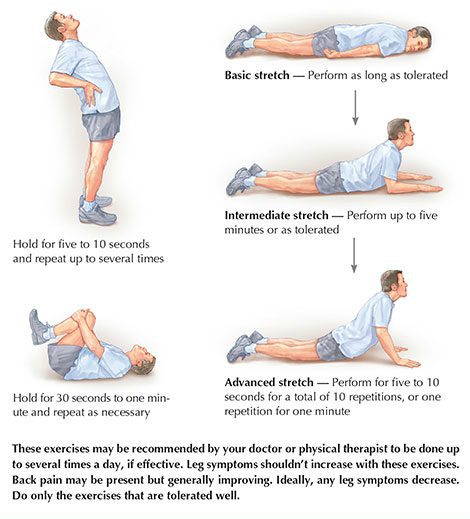8 Ways to Treat Sciatica Naturally
How to Relieve Sciatic Nerve Pain
Sciatica is one of the most common forms of back pain afflicting as many as 40 percent of adults at some point in their lifetime. Although sciatica originates in the lower back, the sciatic nerve travels through the buttocks and down each leg to the foot. So the pain may be worse in the buttocks and leg than in the back. But wherever the pain shows up it can be excruciating!
Common symptoms can range from a dull ache to sharp pain. You may also experience numbness, weakness, or tingling.
The pain may worsen as a result of:[1]
- Prolonged sitting
- Standing up
- Coughing or sneezing
- Twisting one’s torso
- Lifting
- Straining
Causes of Sciatica
The most common cause of sciatica is a herniated disk. The injured disk bulges into the spinal column and pinches the sciatic nerve.[2] Often people don’t know how they even injured their back when the pain comes on.
Some of the causes of such an injury, or conditions that make one more prone to injury include:[3]- Improper lifting
- Prolonged sitting
- Lack of exercise
- Being overweight
- Poor posture
- Deficiencies in vitamins D and K2
- Smoking
- Insufficient sleep
Sciatic symptoms can also start with spinal stenosis. This is the narrowing in one or more areas of your spine. By age 50, most people’s spines show at least some signs of wear and tear of the disks and spinal (facet) joints. Because of this, spaces between the vertebrae narrow and bony growths or disk bulges may form, which can compress sciatic nerve roots.
As they say, “Prevention is always better than the cure!” So awareness of the above causes and conditions can help you avoid back pain and sciatica. But once the pain comes on all you can think about is getting rid of it.
Naturally, the first thing most people think of when suffering with sciatic nerve pain is taking medication to relieve the pain. Over-the-counter pain relievers may help, but if the pain is severe enough, people often go to their doctor for a prescription for something stronger. Usually, in such cases, opioid drugs are prescribed. But these drugs are highly addictive, often abused and now rank higher in fatal drug overdoses than heroin or cocaine![4]
In addition to the above, drugs—even over-the-counter ones—are not good for you long-term and can lead to many other health problems. One of the most well-known risks of painkillers is liver damage from acetaminophen.
Taking ibuprofen and naproxen doesn’t pose as great a risk to liver function as acetaminophen. However, some damage to the stomach lining is a possibility, which can lead to blood loss from the irritated area, stomach pains (gastritis), and even ulcers. This is also true of aspirin.
That’s why we encourage more natural approaches for relief from sciatic nerve pain. These natural methods can be very effective without the dangerous side effects of drugs.
8 Natural Approaches for Relief of Sciatica
- Chiropractic manipulation – A 2010 study in the Journal of Manipulative and Physiological Therapeutics found that 60 percent of people with sciatic pain experienced the same degree of relief from spinal manipulation as those who eventually had surgery.[5]The study involved 120 people who began with three chiropractic visits a week for a month, then tapered off to once a week, and finally discontinued visits when they felt better.
- Acupuncture – This is a traditional Chinese medical practice that involves the use of very tiny, nearly pain-free needles. These needles are strategically placed in the body to release the body’s natural flow of energy. Acupuncture helps reprogram the muscles to stay relaxed. It actually makes your body capable of healing itself. The FDA has approved acupuncture as a treatment for back pain and sciatica.[6]Some people begin feeling relief after the first treatment, but it usually takes about 12 sessions to experience more permanent relief.[7]
- Yoga and stretching – Strengthening the abdominal and back muscles support your back and relieve back pain due to sciatic nerve. Flexibility releases your tight muscles to help get relief from sciatic pain. Initial stretching of the affected area may actually temporarily increase your pain.[8] Take care to follow gentle yoga and stretching techniques. Proper stretching does not involve “bouncing,” but should be slow and deliberate.The diagram here demonstrates a few stretching exercises that to help you regain normal back mobility and improve symptoms. There are also a wide variety of yoga poses and stretching exercises easily available through a Google search. Or, try these below.
- Massage and Rolfing – Both of these methods involve deep manipulation of the soft tissues of the body. This opens muscles, improves blood flow and relaxes affected areas. Both have been shown to relieve sciatic pain.Rolfing was developed by Dr. Ida Rolf in the mid-20th Rolfing is also known as structural integration and seeks to realign the myofascial structure of the body to achieve balance.[9] This type of deep tissue massage and anatomical alignment can resolve discomfort and pain from sciatica.
- Inversion therapy – Inversion therapy uses gravity to realign the body and provide relief of sciatic pain. The most common approach for inversion therapy today is the inversion table. This is a piece of equipment that you lie down on. It clamps your feet in place and then you slowly lower yourself backward so that you are nearly hanging upside down.This method is as old as Hippocrates (400 BC). By allowing gravity to pull your body in the opposite direction it decompresses your spine. This relief of pressure on the spine offers relief from the sciatic pain as well.[10] Some years ago my wife was suffering from lower back pain. After repeated visits to the chiropractor, he recommended an inversion table to her. We purchased one and she began using it from time to time as pain would flare up. The inversion table brought her relief and eliminated her need for the chiropractor!
- Ice or heat – These treatments can’t repair what’s deep within the body, but they can provide temporary relief. Apply either hot or cold to the area in pain for 15 minutes.[11] Always take care to protect your skin from hot or cold burns with a towel or other soft cloth.
- Exercise – Your back or leg pain will probably scream at your initial attempts to exercise. But exercise is one of the best things you can do to alleviate sciatic pain and prevent future occurrences.When you don’t exercise or move your body enough, the muscles get weakened. This weakening of muscles leads to back injury and strain, which then causes pain. Exercising also keeps your spinal discs healthy. If you don’t move them enough, they will not be able to circulate fluids as well as nutrients that help them stay healthy and prevent pressure on the sciatic nerve. Exercise as simple as walking can help realign your spine, warm up your muscles, get your blood flowing, reduce inflammation, and release endorphins—your body’s natural pain killers.[12] Start slowly and gradually increase duration and intensity.
- Topical preparations – Dr. Tieraona Low Dog, MD, director of the fellowship at the Arizona Center for Integrative Medicine recommends St. John’s wort oil for nerve pain. Apply this anti-inflammatory oil on the affected area two or three times a day.[13]Cayenne pepper cream is another option for relieving inflammation due to sciatic nerve pain. Dr. Low Dog prescribes the chile patch Qutenza for severe cases of pain.[14]
Normally, sciatic pain subsides within six weeks of conservative care. But with persistent sciatic nerve pain, some people opt for surgery. If symptoms remain debilitating, if muscle weakness begins and loss of bladder or bowel control is present, then surgery can be a viable option. This is especially true with sciatica caused by progressive spinal stenosis. But keep in mind that it’s not necessarily permanent.[15] If you decide to go the route of surgery with your doctor’s recommendation, you will want to take preventative measures afterward to ensure that injuries and pain don’t recur.
Meanwhile, check with your doctor and try one or more of the above natural remedies for sciatica. You’ll kill two birds with one stone by relieving your sciatic pain and conditioning your body against future attacks.



























